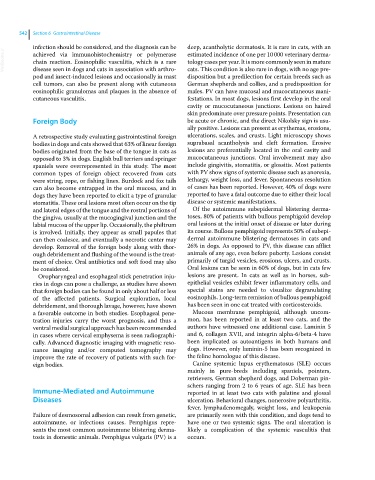Page 574 - Clinical Small Animal Internal Medicine
P. 574
542 Section 6 Gastrointestinal Disease
infection should be considered, and the diagnosis can be deep, acantholytic dermatosis. It is rare in cats, with an
VetBooks.ir achieved via immunohistochemistry or polymerase estimated incidence of one per 10 000 veterinary derma
tology cases per year. It is more commonly seen in mature
chain reaction. Eosinophilic vasculitis, which is a rare
disease seen in dogs and cats in association with arthro
disposition but a predilection for certain breeds such as
pod and insect‐induced lesions and occasionally in mast cats. This condition is also rare in dogs, with no age pre
cell tumors, can also be present along with cutaneous German shepherds and collies, and a predisposition for
eosinophilic granulomas and plaques in the absence of males. PV can have mucosal and mucocutaneous mani
cutaneous vasculitis. festations. In most dogs, lesions first develop in the oral
cavity or mucocutaneous junctions. Lesions on haired
skin predominate over pressure points. Presentation can
Foreign Body be acute or chronic, and the direct Nikolsky sign is usu
ally positive. Lesions can present as erythemas, erosions,
A retrospective study evaluating gastrointestinal foreign ulcerations, scales, and crusts. Light microscopy shows
bodies in dogs and cats showed that 63% of linear foreign suprabasal acantholysis and cleft formation. Erosive
bodies originated from the base of the tongue in cats as lesions are preferentially located in the oral cavity and
opposed to 3% in dogs. English bull terriers and springer mucocutaneous junctions. Oral involvement may also
spaniels were overrepresented in this study. The most include gingivitis, stomatitis, or glossitis. Most patients
common types of foreign object recovered from cats with PV show signs of systemic disease such as anorexia,
were string, rope, or fishing lines. Burdock and fox tails lethargy, weight loss, and fever. Spontaneous resolution
can also become entrapped in the oral mucosa, and in of cases has been reported. However, 40% of dogs were
dogs they have been reported to elicit a type of granular reported to have a fatal outcome due to either their local
stomatitis. These oral lesions most often occur on the tip disease or systemic manifestations.
and lateral edges of the tongue and the rostral portions of Of the autoimmune subepidermal blistering derma
the gingiva, usually at the mucogingival junction and the toses, 80% of patients with bullous pemphigoid develop
labial mucosa of the upper lip. Occasionally, the philtrum oral lesions at the initial onset of disease or later during
is involved. Initially, they appear as small papules that its course. Bullous pemphigoid represents 50% of subepi
can then coalesce, and eventually a necrotic center may dermal autoimmune blistering dermatoses in cats and
develop. Removal of the foreign body along with thor 26% in dogs. As opposed to PV, this disease can afflict
ough debridement and flushing of the wound is the treat animals of any age, even before puberty. Lesions consist
ment of choice. Oral antibiotics and soft food may also primarily of turgid vesicles, erosions, ulcers, and crusts.
be considered. Oral lesions can be seen in 60% of dogs, but in cats few
Oropharyngeal and esophageal stick penetration inju lesions are present. In cats as well as in horses, sub
ries in dogs can pose a challenge, as studies have shown epithelial vesicles exhibit fewer inflammatory cells, and
that foreign bodies can be found in only about half or less special stains are needed to visualize degranulating
of the affected patients. Surgical exploration, local eosinophils. Long‐term remission of bullous pemphigoid
debridement, and thorough lavage, however, have shown has been seen in one cat treated with corticosteroids.
a favorable outcome in both studies. Esophageal pene Mucous membrane pemphigoid, although uncom
tration injuries carry the worst prognosis, and thus a mon, has been reported in at least two cats, and the
ventral medial surgical approach has been recommended authors have witnessed one additional case. Laminin 5
in cases where cervical emphysema is seen radiographi and 6, collagen XVII, and integrin alpha‐6/beta‐4 have
cally. Advanced diagnostic imaging with magnetic reso been implicated as autoantigens in both humans and
nance imaging and/or computed tomography may dogs. However, only laminin‐5 has been recognized in
improve the rate of recovery of patients with such for the feline homologue of this disease.
eign bodies. Canine systemic lupus erythematosus (SLE) occurs
mainly in pure‐breds including spaniels, pointers,
retrievers, German shepherd dogs, and Doberman pin
schers ranging from 2 to 6 years of age. SLE has been
Immune‐Mediated and Autoimmune reported in at least two cats with palatine and glossal
Diseases ulceration. Behavioral changes, nonerosive polyarthritis,
fever, lymphadenomegaly, weight loss, and leukopenia
Failure of desmosomal adhesion can result from genetic, are primarily seen with this condition, and dogs tend to
autoimmune, or infectious causes. Pemphigus repre have one or two systemic signs. The oral ulceration is
sents the most common autoimmune blistering derma likely a complication of the systemic vasculitis that
tosis in domestic animals. Pemphigus vulgaris (PV) is a occurs.

